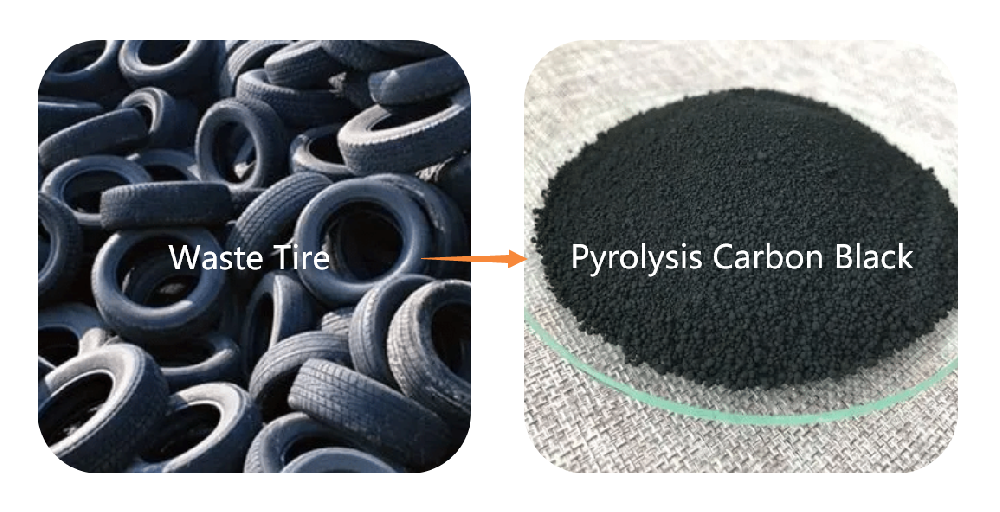For product information and pricing, Chat with sales agent:
or email us : sales@clirik.com
Click links below to see related products.

This market feasibility report analyzes the potential of tire pyrolysis carbon black as a commercial product. Tire pyrolysis carbon black is a valuable byproduct of the tire pyrolysis process, which converts waste tires into fuel oil, gas, and carbon black. The market feasibility report analyzes the market demand, supply chain, competition, potential customers, and revenue potential for tire pyrolysis carbon black.

Tire Pyrolysis Carbon Black
Tire pyrolysis carbon black is a substitute for virgin carbon black, which is used in various industries such as rubber, plastics, paints, inks, and coatings. The global carbon black market size was valued at USD 13.79 billion in 2020 and is expected to reach USD 17.6 billion by 2027, growing at a CAGR of 3.5% from 2020 to 2027. The increasing demand for carbon black in various industries is due to its unique properties such as UV protection, electrical conductivity, and abrasion resistance. The demand for tire pyrolysis carbon black is expected to grow as more companies are focusing on sustainability and circular economy initiatives.
The supply chain for tire pyrolysis carbon black starts with the collection of waste tires, which are then processed through the pyrolysis process to produce fuel oil, gas, and carbon black. The carbon black is then processed to remove impurities and ensure the quality of the product. The final product is then sold to customers in various industries.
The competition in the tire pyrolysis carbon black market is low compared to the virgin carbon black market. However, there are a few established players such as Pyrolyx AG, Delta Energy, and Black Bear Carbon, who have significant market share. New entrants into the market may face challenges such as high capital investment, regulatory requirements, and customer acquisition.
The potential customers for tire pyrolysis carbon black are companies in various industries such as rubber, plastics, paints, inks, and coatings. These industries use carbon black as a key ingredient in their products. The demand for sustainable products and circular economy initiatives is driving the interest in tire pyrolysis carbon black.
The revenue potential for tire pyrolysis carbon black depends on several factors such as the quality of the product, pricing strategy, customer acquisition, and production capacity. According to industry reports, the price of tire pyrolysis carbon black ranges from USD 600 to USD 1,200 per ton, depending on the quality of the product. The revenue potential for a typical tire pyrolysis plant producing 5,000 tons of carbon black per year could be around USD 3 million to USD 6 million.
Based on the analysis of the market feasibility report, the following recommendations are suggested for companies interested in entering the tire pyrolysis carbon black market:
Conduct a thorough market analysis: Before entering the market, companies should conduct a thorough market analysis to understand the demand for tire pyrolysis carbon black, the competition, potential customers, and revenue potential.
Develop a high-quality product: The quality of tire pyrolysis carbon black is essential to its market success. Therefore, companies should invest in developing a high-quality product that meets the requirements of various industries.
Focus on sustainability: The increasing demand for sustainable products and circular economy initiatives presents an opportunity for companies to differentiate themselves in the market. Therefore, companies should focus on sustainability and communicate their sustainability efforts to potential customers.
Invest in customer acquisition: The potential customers for tire pyrolysis carbon black are companies in various industries. Therefore, companies should invest in customer acquisition strategies to reach potential customers and promote their product.
Monitor regulatory requirements: The tire pyrolysis carbon black market is subject to regulatory requirements, and companies should monitor the regulatory landscape and ensure compliance with relevant regulations.
While there are opportunities for companies interested in entering the tire pyrolysis carbon black market, there are also potential challenges to consider:
High capital investment: Setting up a tire pyrolysis plant requires significant capital investment, including the cost of equipment, labor, and regulatory compliance. Companies should carefully evaluate the costs and potential returns before investing in a tire pyrolysis plant.
Limited feedstock availability: The availability of waste tires, the primary feedstock for tire pyrolysis plants, is limited in some regions. Companies should ensure they have access to an adequate supply of feedstock before investing in a tire pyrolysis plant.
Quality consistency: The quality of tire pyrolysis carbon black can vary depending on the feedstock and the pyrolysis process. Consistency in product quality is essential to customer satisfaction and market success.
Regulatory compliance: The tire pyrolysis carbon black market is subject to regulatory requirements, including environmental regulations and waste management regulations. Companies must comply with relevant regulations to operate in the market.
The market feasibility report suggests that the tire pyrolysis carbon black market has potential for growth, given the increasing demand for sustainable products and circular economy initiatives. The competition in the market is low, but new entrants may face challenges such as high capital investment and regulatory requirements. The revenue potential for tire pyrolysis carbon black depends on several factors, but a typical plant producing 5,000 tons of carbon black per year could generate revenue of around USD 3 million to USD 6 million.
The tire pyrolysis carbon black market has potential for growth, given the increasing demand for sustainable products and circular economy initiatives. Companies interested in entering the market should conduct a thorough market analysis, focus on developing a high-quality product, prioritize sustainability, invest in customer acquisition, and monitor regulatory requirements. With the right strategies and investments, companies can capitalize on the market potential of tire pyrolysis carbon black.
In conclusion, the tire pyrolysis carbon black market presents opportunities for companies interested in sustainable products and circular economy initiatives. However, companies should carefully evaluate potential challenges, including high capital investment, limited feedstock availability, quality consistency, and regulatory compliance. With the right strategies and investments, companies can overcome these challenges and capitalize on the market potential of tire pyrolysis carbon black.
